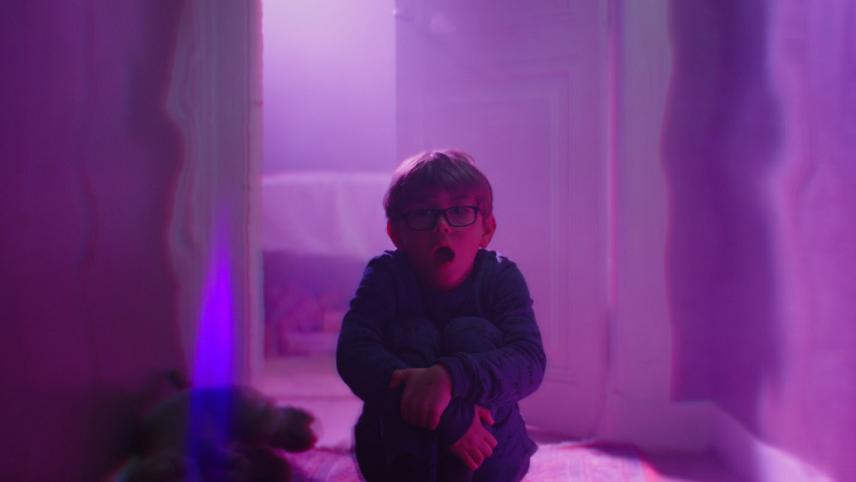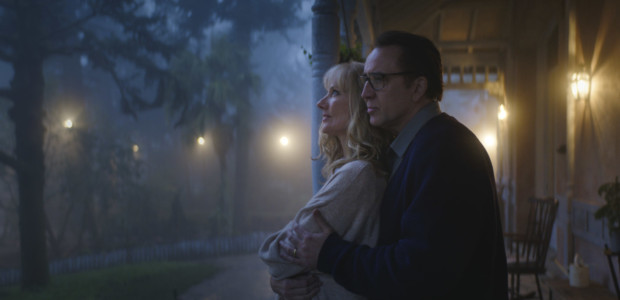“Something terrible came to the hills and valleys on that meteor, and something terrible — though I know not in what proportion — still remains.” – H.P. Lovecraft, The Colour Out of Space

It can be incredibly risky, giving a visionary artist free rein over adapting the distinctive work of another creative force whose work is known as much for its singular voice as it is its enduring influence. It’s hard enough to make any movie at all, let alone one that’s creatively ambitious on nearly every conceivable level. That goes double when the work being adapted is from the likes of Howard Phillips Lovecraft, the king of cosmic fuckery himself. Not only one of the most influential writers in genre literature, Lovecraft’s stories have also inspired decades of films that range from admirable deviations to complete trainwrecks that end up barely glancing at their source material.
When it was announced that Richard Stanley, he of HARDWARE and DUST DEVIL fame and THE ISLAND OF DR. MOREAU infamy, would be helming Lovecraft’s “The Colour Out of Space,” I was ecstatic. This is a filmmaker who doesn’t only take some real gonzo chances on screen, but in so many interviews he’s also enthusiastically showed pages of art and storyboards he created and either wasn’t allowed to use or has yet to have the chance. It’s no secret that Stanley has been done dirty in the Hollywood studio system, namely from the Weinsteins, but it seems nothing can diminish his enthusiasm for creating and taking chances in the medium. Thank the elder gods for that, because COLOR OUT OF SPACE is, yes, a truly fantastic Lovecraft movie, but it’s also the Richard Stanley movie that Richard Stanley fans have been waiting for.
The film puts the Gardner clan in its center, a loving family that nonetheless has taken a few knocks over the years and understandably has some spiky moments between each other because of them. After a straight-off-the-page, ominous but beautifully dreamlike narrated opening that immediately dips us into the strange waters of Arkham, the film opens with the teenage Lavinia (Madeleine Arthur) performing a Wiccan healing ritual directed towards her mother, Theresa (Joely Richardson), who’s recovering from cancer treatment. She’s interrupted by Ward Phillips (Elliot Knight), a young, cheerful hydrologist whose surveying some recent water issues in the area. They instantly charm each other, building a mildly flirtatious but ultimately innocent rapport. It’s a sincere moment of earth magic meeting science, but more importantly, a human meeting a human. Having this scene immediately follow the ominous words of Lovecraft sets the stage for the delicate balancing act the film now has to perform when it comes to giving us humanistic moments later on when the threat of cell-splitting annihilation starts infecting their lives.

Soon we meet the rest of the family: affable and slightly weird dad Nathan (Nicolas Cage), young, precocious cutie pie Jack (Julian Hilliard), mildly rebellious teenage son Benny (Brendan Meyer) and the strong but healing and insecure matriarch, Theresa (Richardson), whose stress of her recent illness is compounded by bad WiFi at their remote location when she’s trying to make money by working from home. There’s a low thrum of stress in this house, but it’s that kind most regular, loving families have.
Most notable in these scenes is the relationship between Nathan and Theresa. He wants them to finally make love again after the vagaries of her illness and treatments put a stop to that for a long spell. “I feel tarnished,” she tells him. It’s tender and romantic and heartbreaking, and Cage and Richardson are impossibly gentle and sweetly funny with each other. This beauty is terrifying: Even those unfamiliar with the plot know that some kind of hell awaits this lovely family, and it’s nearly cruel seeing them so warm in such quiet moments.
Indeed, the night culminates in a bright color exploding the sky as a meteor crashes onto their property, causing strange electrical reactions and a short-term, almost fugue state for youngest son Jack, but ultimately it’s fine. The next day the PR-focused mayor (Q’orianka Kilcher) and that nice hydrologist Ward show up again to survey the damage. In the sunshine, it’s all played as a pretty fun light comedy. Nathan is nervous and awkward in front of the news cameras that show up later, and Ward’s investigation into the water supply leads him to Ezra, portrayed by Tommy Chong himself, who plays the character’s oddball hippie personality quirks as solidly as he plays his preternatural sense of what’s really going to go on around these parts.

Soon, small accidents start. There are whispers from the Gardners’ well. The animals are acting strangely. This is when those seeing the film for Nic Cage’s performance will get excited, as his energy starts ramping up to match the heightened events. Cage isn’t stunt casting, however, and on some level, he might be one of the very few actors alive who could play Nathan’s role, which ping-pongs between the stern patriarch and loving husband to a man infected by an impossible, cancerous madness. A brash fearlessness is needed for this film, and Cage delivers.
The effects are truly stunning. From creatures great and small and strange to body horrors that rival, and in many cases surpass, anything from a Stuart Gordon/Brian Yuzna Lovecraft production, the film is as stunning to look at as it is grotesque. The characters and their relationships bewitched me, but make no mistake: COLOR OUT OF SPACE does not shy away from showing the goods. This is a tender but gruesome horror film, and Richardson’s Theresa seems almost biblically doomed to bear the brunt of the betrayal of infected flesh.

Lovecraft was notoriously uninterested in crafting dialogue and writing about “ordinary people,” instead putting his energies into horrifying entities, the aberrations of clashing dimensions, and very effectively conjuring horrific atmospheres. That’s been quite the hindrance for many filmmakers over the years, especially ones who are also more adept as visual flourishes and mood building rather than being masters of prose and character journeys themselves. COLOR OUT OF SPACE’s biggest strength — outside of its lush visual terrors — is that it puts in the time to build the chemistry both within and without the Gardner family. When the antagonist in the story is an unstoppable force beyond our human understanding, we do need a human or two we can relate to.
The script by Stanley and Scarlett Amaris enriches the story with a more approachable and relatable earthbound mysticism and paganism than Lovecraft employed, and it adds an intriguing new angle of grounding the cosmogonic struggle between soil and skin and color and madness. It gives a quiet strength to characters who aren’t given any mercy, and it’s about as faithful to the original story as an adaptation concerned with giving its characters inner lives and wrapping the entire affair a contemporary point of view can be.

COLOR OUT OF SPACE is an effective horror film with an unrelentingly grim sci-fi bent. Much of its power lays in a love of genre madness: gore, outsized performances, perversions of science, creatures born of imagination rather than of nature, and lots and lots of nasty, spurting goo. COLOR succeeds because it employs those macabre joys rather than relying on them alone, and it therefore becomes chillingly potent at portraying the horrors of the flesh, the soul, and the unknown.

“And the secrets of the strange days will be one with the deep’s secrets; one with the hidden lore of old ocean, and all the mystery of primal earth.” – H.P. Lovecraft, The Colour Out of Space
Tags: Brendan Meyer, Brett W. Bachman, Colin Stetson, Daniel Noah, elijah wood, Elliot Knight, H.P. Lovecraft, Horror, Joely Richardson, Josh Waller, Lisa Whalen, Madeleine Arthur, Nicolas Cage, Q'orianka Kilcher, richard stanley, RLJE Films, Scarlett Amaris, Sci-Fi, Steve Annis, The Universe, Tommy Chong, XYZ Films


No Comments